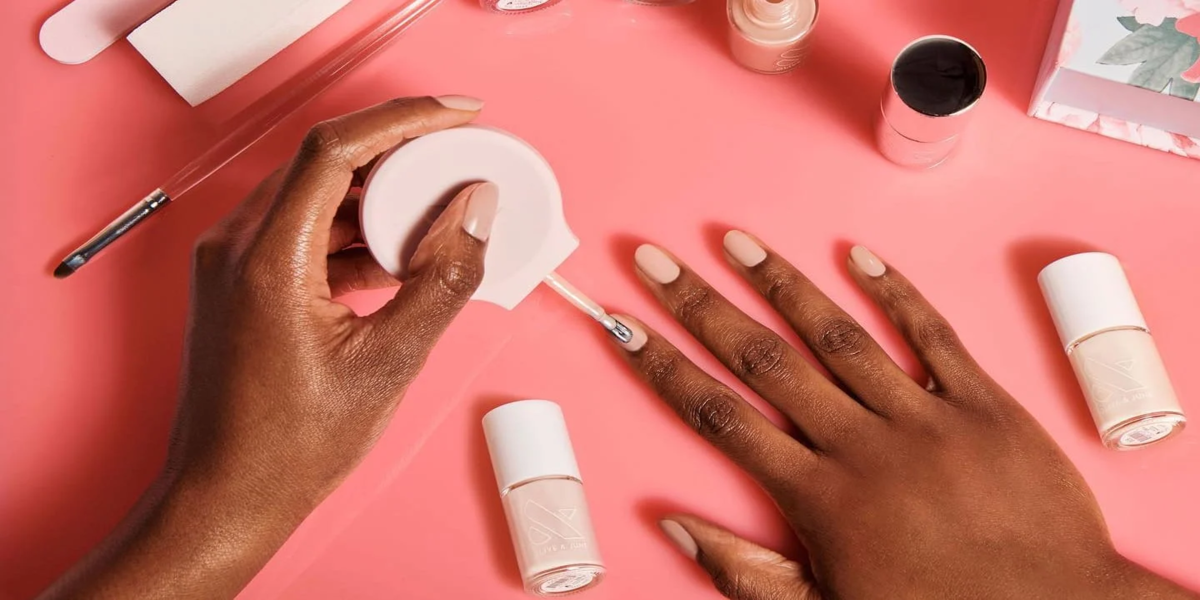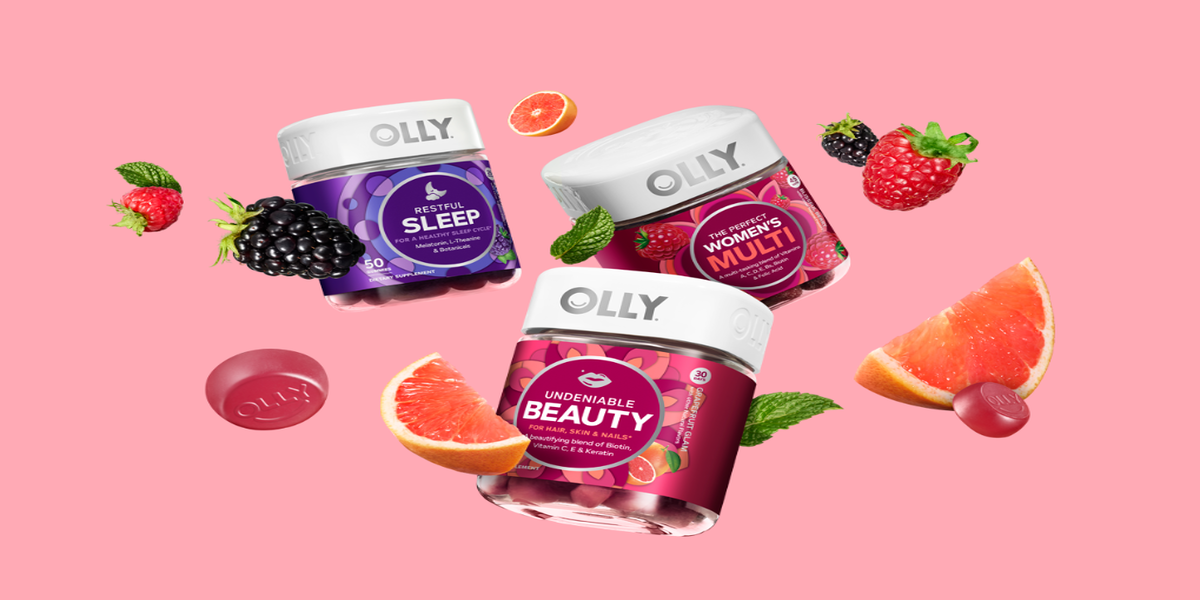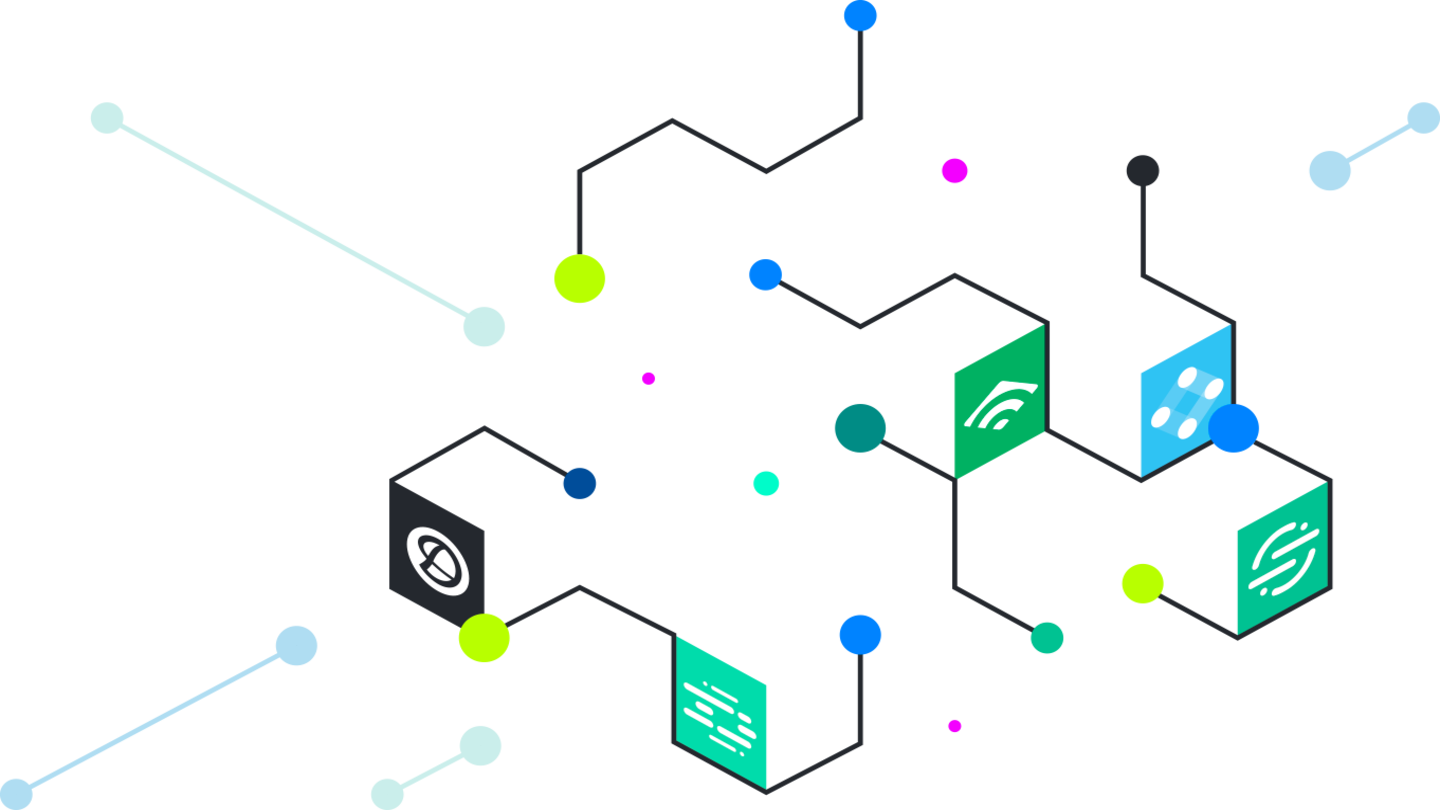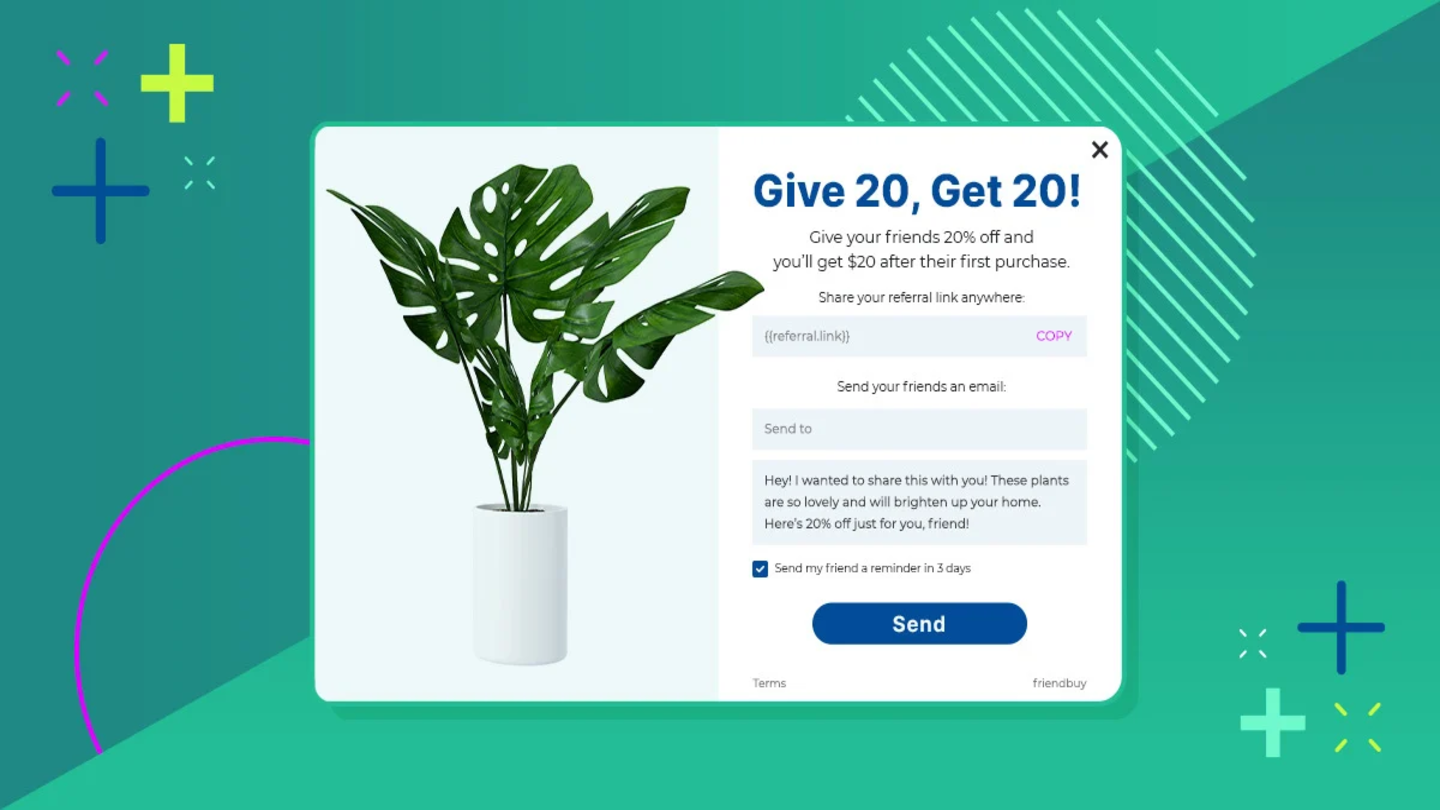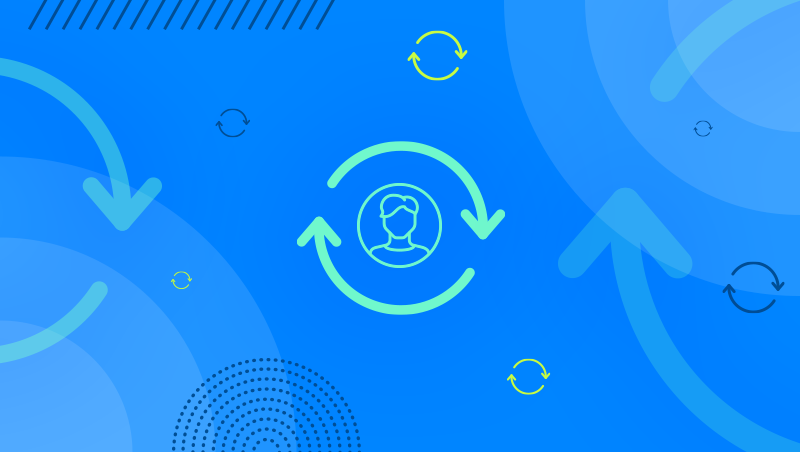Your repeat customers are your best customers, but how do you keep customers coming back for more?
Read the below or watch the replay from the live event to learn how you can:
💰 Encourage repeat purchases (and even more acquisition) through customized referral and loyalty rewards
📈 Personalize upsells and cross-sells to increase repeat purchase rates
🚚 Optimize shipment tracking opportunities to encourage repeat purchases, as well as drive referral program awareness
After a surge in traffic to your ecommerce site, say, after the BFCM and holiday rush, you likely acquired some new customers. Which is great news, so take a moment to pat yourself on the back.
Now, it's time to ask yourself how you can keep those new customers coming back to buy again. After all, retaining customers and increasing their lifetime value will be key to hitting your growth goals, especially in 2023. This article will give you the playbook to do just that.
Step 1: Encourage repeat purchases (and even more acquisition) with your Referral and Loyalty Programs
One key way you can keep customers coming back for the long run is through your referral and loyalty programs.
Let’s start with loyalty programs, as they are strong drivers of retention and are a proven and successful way to build long-lasting relationships with customers through valuable rewards, experiences, and brand connections.
In fact, 79% of consumers say loyalty programs make them more likely to continue doing business with brands.
You might be asking, what is it that makes loyalty programs so successful at keeping your customers?
The first reason, is that a loyalty program connects consumers to your brand. If you want to stay top of mind when a purchasing decision is about to be made, a loyalty program is a great way to accomplish that.
Secondly, loyalty is a frequency driver. Most loyalty programs are gamified in some way to drive purchase frequency. And, 73% of consumers are more likely to recommend brands with good loyalty programs, meaning you’ll increase customer acquisition through referrals.
Also, you might release new products from time to time. You can use a rewards program to jumpstart new product sales within specific customer segments. According to Harvard Business Review, companies with leading loyalty programs grow revenue 2.5x as fast as competitors that don’t.
And finally, collecting zero and first-party data continues to rise in importance as privacy concerns make it more difficult to leverage third party data. A loyalty program is an excellent way to collect zero and first-party data in a value exchange between you and your customers. As we know, loyalty programs are not one-size-fits-all.
As a brand, you’ll want to determine the type of loyalty program that will delight your customers and in turn, help grow your business.
How do I set up a loyalty program for my business?
Now, you can't just start handing out points to your customers every now and then and call it a loyalty program. I mean you can, but, it likely won't work. Like all good marketing strategies, your loyalty program needs to match your brand identity and goals, and resonate with your audience. It also demands robust loyalty program software that can scale with you.
When looking at how to set up your loyalty program to succeed, there are a few key questions worth asking.
What rewardable events matter most for your business?
Some standard actions to reward customers for taking include subscribing to emails and texts, or when they share their birthday. But, maybe you want to increase mobile app downloads, so you reward customers for doing just that. Or, you may want to reward customers for subscribing to a product for more than six months, or for adding a product to their order through an upsell.
.jpg?width=1000&height=378&name=botanictonics%20loyalty%20program%20ways%20to%20earn%20points%20(1).jpg)
Think creatively about what actions move your business forward, and reward customers for taking them.
What are the most compelling rewards to keep your customers loyal?
Is it points that can be redeemed for store credit or coupon codes? Or, maybe you’d like to offer truly custom rewards, like monograms if you’re selling luggage. Or, special access to events or new products just for your VIPs.
.jpg?width=1000&height=464&name=oliveandjune%20redeem%20rewards%20(1).jpg)
Consider surveying your customers to learn what kinds of rewards and experiences would be most valuable to them, and solicit feedback from your customer experience team on what kinds of rewards and experiences they think your customers would value most.
What rules do you need to set up to control which action qualifies a member to earn a reward?
You'll want to ensure loyalty program integrity by setting up fraud detection and reward rules that make sure only customers that are taking the right action are rewarded.
For example, you may want to account for:
- New customer validation
- A minimum purchase threshold
- Reward delays and caps
- Customer authentication
How can a referral program keep customers coming back?
Now, you may be wondering where referral programs fit into the picture since it's primarily seen as an acquisition channel.
But it actually lives a not-so-secret double life, as not only do they help accelerate acquisition, they also help to increase retention.
When you reward customers for referring their friends and family, you're also incentivizing those Advocates to come back and make another purchase using the rewards they’ve earned.
And those are the folks you most want returning as customers, as Advocates often have higher average order values (AOV) and lifetime values (LTV) than non-referring customers.
A referral program is now table stakes as part of a customer acquisition and retention strategy.
Let’s talk about why they’re such a strategic growth driver. First and foremost, referral programs have jaw-droppingly low costs-per-acquisition (CPA). They drive high-quality new customers by incentivizing existing loyal brand Advocates, with an average CPA of $1 - $10.
Secondly, referral programs can increase conversion rates and AOVs. Referral programs typically generate two to four times higher conversion rates than overall site conversion rates. And our customers typically see higher AOVs from Advocates and referred friends. For example, Natural Dog Company has found Advocates from their Friendbuy referral program have a 20% higher AOV than non-referral customers.
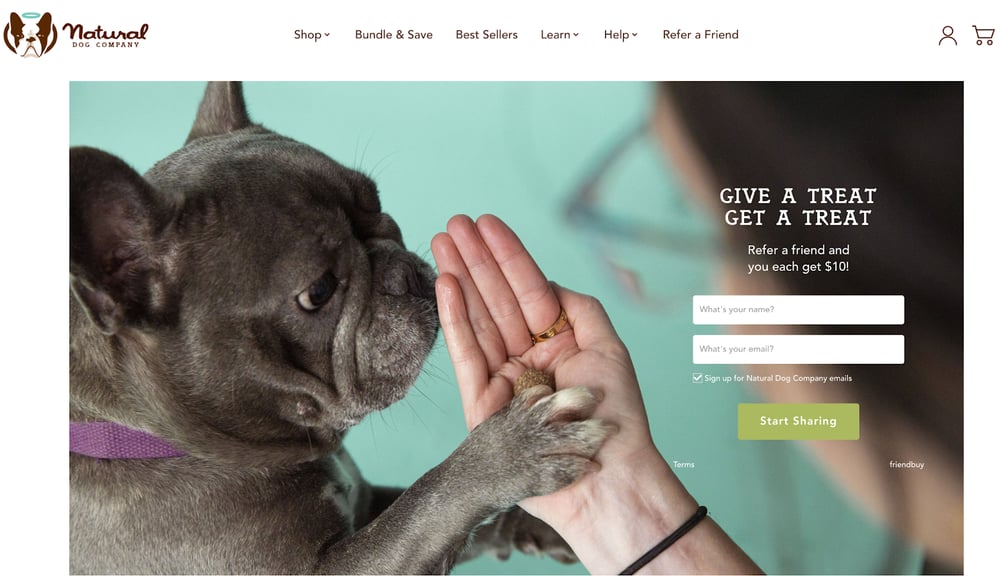
Next, referral programs increase LTV. The LTV of a referred customer is three to four times higher than a customer acquired through a paid channel.
And we saved the best statistic for last ... referral programs help brands with sustainable growth and high ROI. Five to 15% of new customers are acquired through a referral program, with an average 25x return on spend.
Now that we’ve spent some time talking about the value of a referral program, let's walk through a standard referral user flow.
The below example is from a Friendbuy customer, MUD/WTR. They sell a coffee alternative, consisting of organic ingredients like mushrooms, turmeric and cacao.
On the left, you’ll see a call-to-action (CTA) that says “Refer, earn $20.” This is located in their mobile web hamburger menu, and is therefore easily accessible to anyone who’s ready to refer-a-friend.
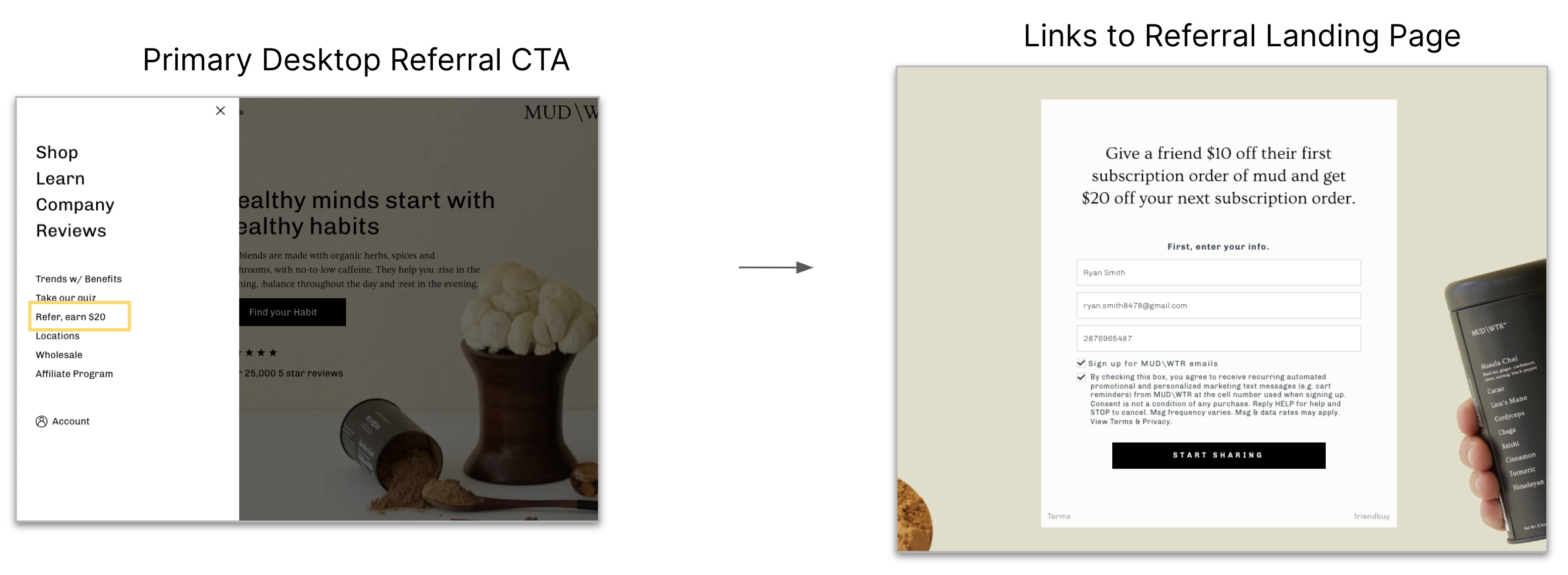
When the CTA is clicked, it drives you to a referral landing page. Now, your Advocates can enter their email, and optionally enter their phone number, in order to start sharing. Friendbuy captures this zero party data, that can be added to your ESP and SMS platforms. This is a great way to increase high-intent subscriber acquisition. And don’t worry, we also include opt-in checkboxes on all widgets to comply with TCPA and CAN SPAM regulations.
Once an advocate as entered their information, they'll have the option to share through a number of channels. For example, they can:
- Send their friends an email
- If they're on their phone, they can send their friend a text with pre-populated copy that has their referral link included
- They can share their referral offer over social media, including Facebook Messenger or Twitter
- Or, they can copy their unique referral link and share it on Slack, Teams, or wherever else they interact with friends, family, and colleagues
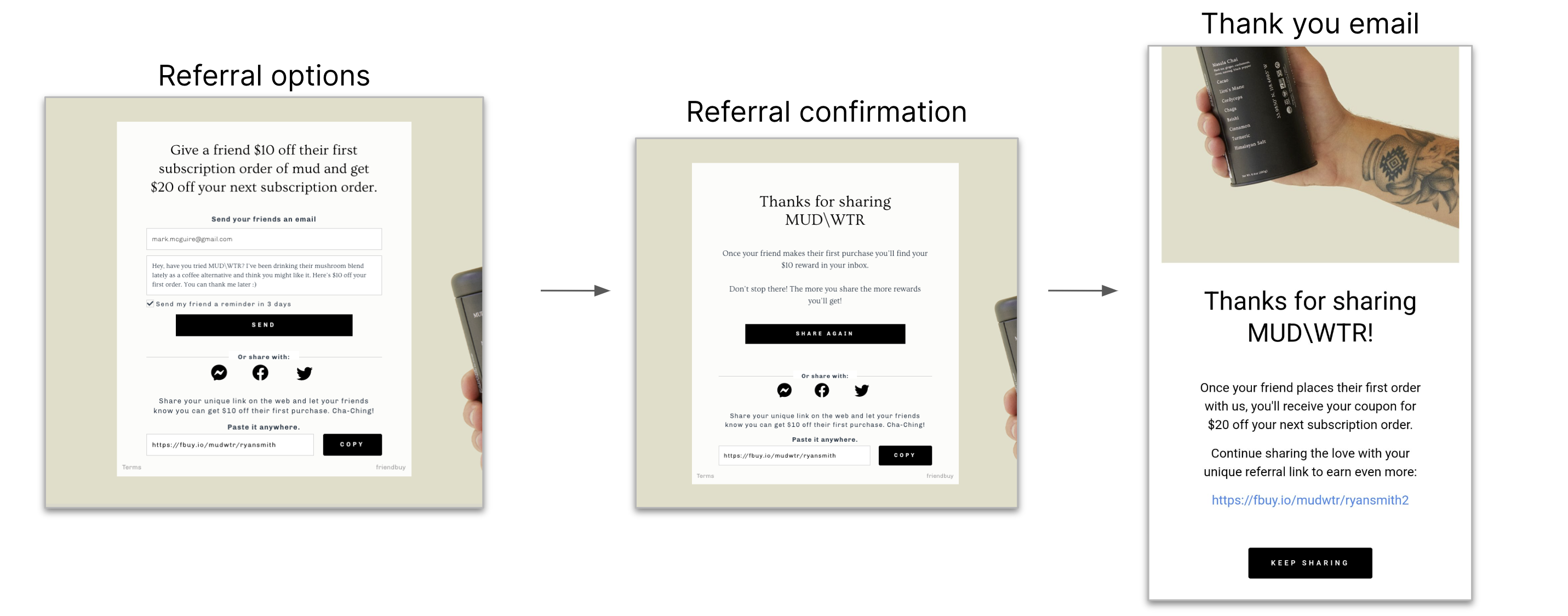 On the right above, you’ll see a thank you email that’s automatically triggered in Friendbuy when an Advocate shares, thanking them for sharing and including their personal referral link.
On the right above, you’ll see a thank you email that’s automatically triggered in Friendbuy when an Advocate shares, thanking them for sharing and including their personal referral link.
The next step in the referral user flow is below, with an example of the referral invitation email that is sent to the referred friend, inviting them to check out MUD\WTR. Plus, the Advocate is giving them $10 off their first order, because they're an awesome friend.
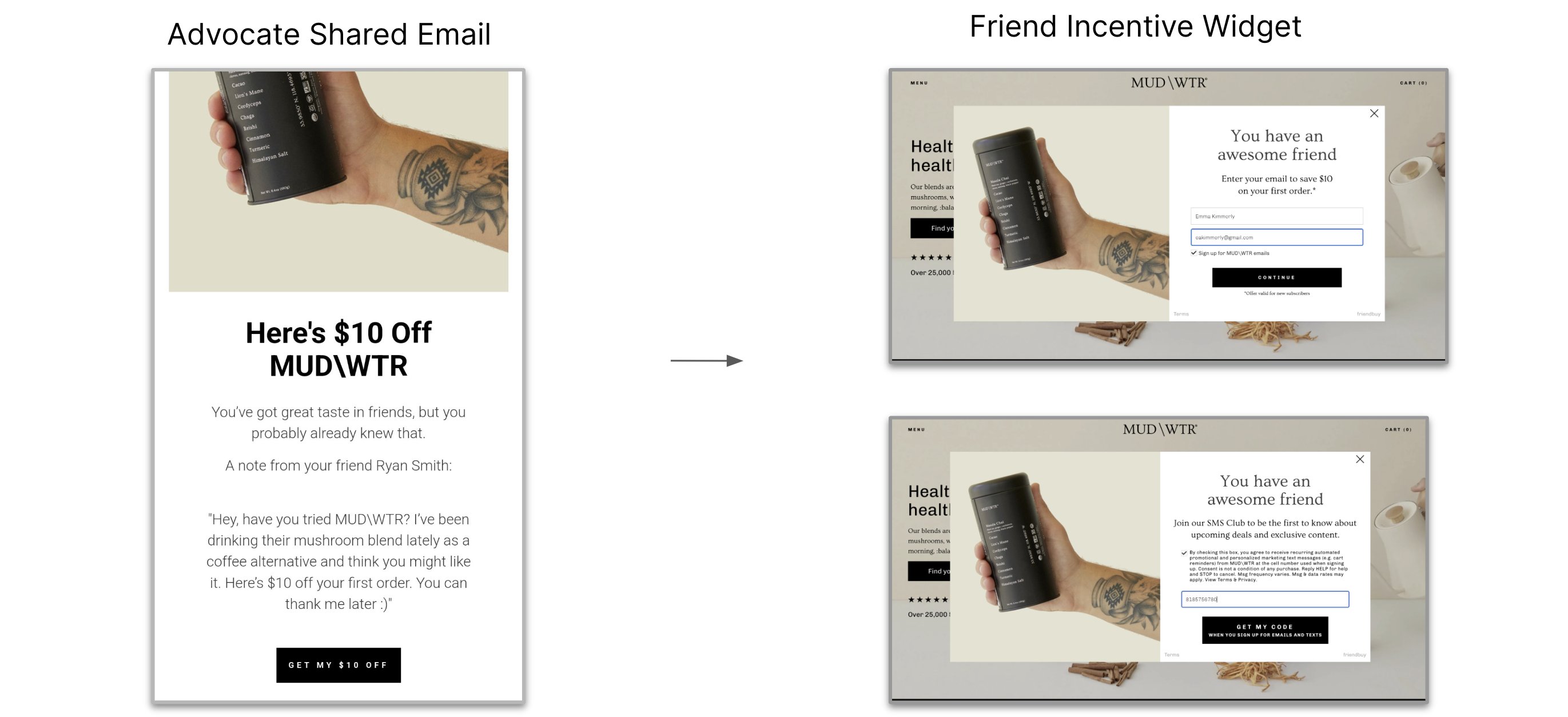
When the referred friend clicks the CTA in the email, they are directed to MUD\WTR’s site and presented with a pop up that invites them to enter their information to receive their $10 off.
After the referred friend enters their information, Friendbuy will do a check to see if they’re a new customer and if they are in fact new, they'll be sent an email with their $10 off coupon code included! Like magic, really.
The referred friend can then apply that coupon code when they checkout. Once that happens, and additional reward validation and fraud checks are passed, the Advocate will receive a $20 reward email, and thus will likely make another purchase from MUD/WTR.
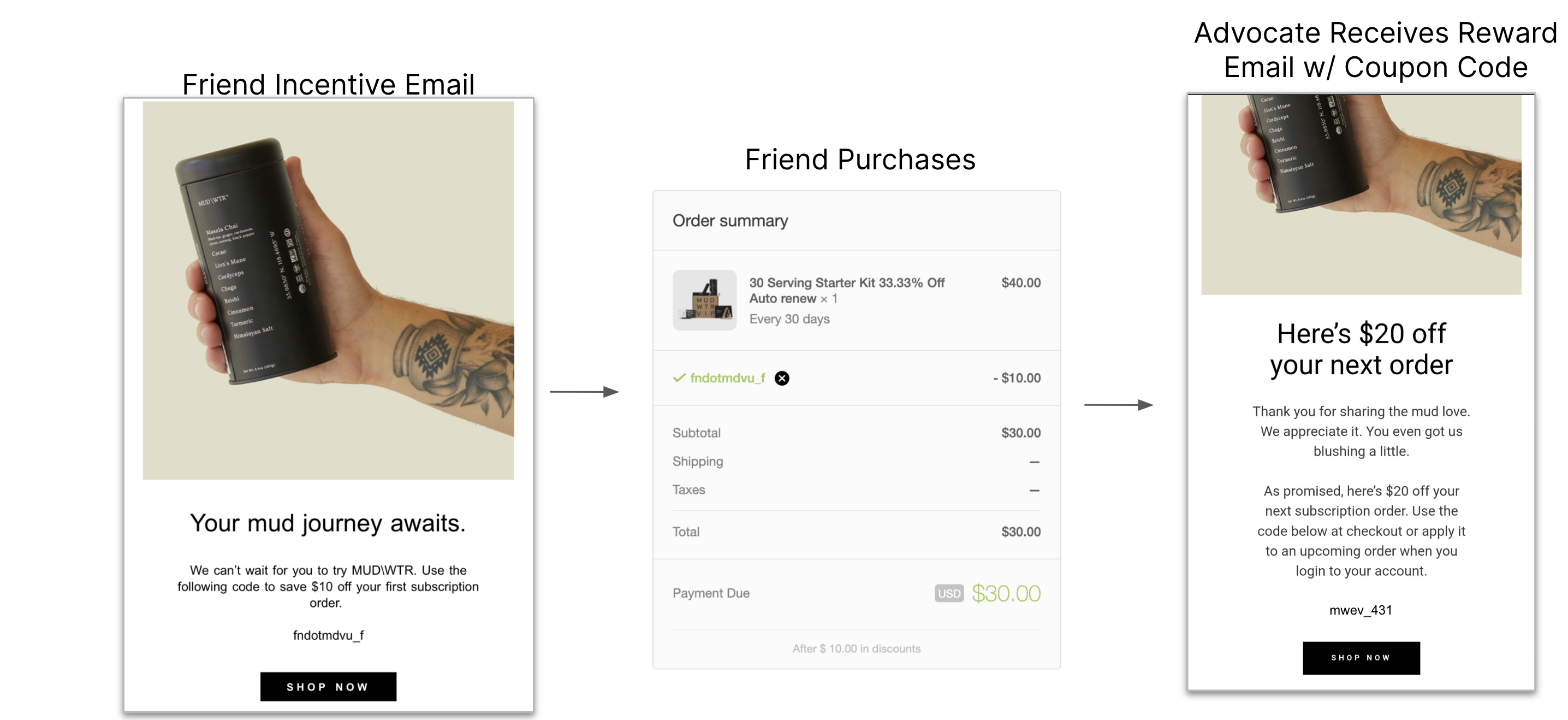
And tada, that's your referral user flow! Now, one key way to keep customers coming back and continuing to refer is by A/B testing that referral offer.
How to A/B test your referral offer
Let's start to answer this question by asking another question, shall we? Do you know what the rule of 100 is?
If you looked it up, that's okay, we forgive you. If you didn't - keep reading, we looked it up for you.
Friendbuy thinks about the rule of 100 in referral marketing as a great way to A/B test your referral offer. If your AOV is under $100, a percentage-based discount—for instance, 30% off—will appear more attractive to customers. Conversely, if your AOV is above $100, a numerical discount—for example, $50 off—will impress customers more and will increase the likelihood that they’ll purchase.
One Friendbuy customer, Get Back Necklaces, put the rule of 100 to the test (A/B test that is) with their referral offer, and saw a 700% increase in referral revenue.
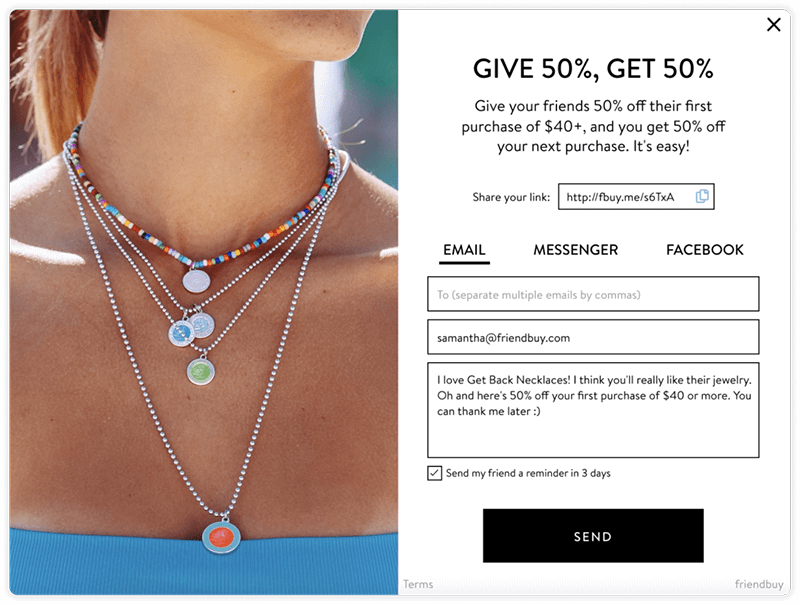
Their initial referral offer was Give $10, Get $10, while their AOV was less than $100. They ran this offer for a while and then, they learned about the rule of 100. So, they decided to A/B test a Give $10, Get $10 offer against a Give 50%, Get 50% offer (which by the way amounted to the exact same discount amount for the customer).
The result was... drum roll please... the percentage-based offer generated twice as much referral revenue compared to the dollar-based offer! This led to a 700% increase in overall referral revenue vs. pre-Friendbuy.
Plus, as mentioned before, referral customers tend to have higher AOVs. And for Get Back Necklaces, their AOV from referred customers is approximately 25% higher than the AOV of non-referral orders.
This example is a great reminder for brands to test their incentive offers as another important way to ensure customers keep coming back to refer and purchase.
Step 2: Personalize upsells and cross-sells to increase repeat purchase rates
Another key way to keep your customers coming back is to personalize your upsells and cross-sells to increase your repeat purchase rates and AOV.
This is significantly easier to do with a personalization platform such as Rebuy. Rebuy customers often see a five to 25% increase in their AOV, and five to 20% of their total revenue come from their omnichannel personalization.
In order to achieve that, brands need to create thoughtful and intelligent shopping experiences. There are three ways to do so:
- Personalized touch points
- Personalized landing pages
- Onsite personalization
1. Driving repeat purchases through personalized touchpoints
There are a lot of ways that brands interact with their customers, and each time you do that, it's an opportunity to include a product recommendation that's personalized. For example, if you use a post-purchase platform such as Malomo, you can put a Rebuy widget in your tracking pages to turn that into a revenue generating opportunity in a personalized way.
Another thing that works really well is special offers. For example, you can include a gift with purchase to increase conversion rates, at a fairly low cost. Or, with bundles, you can increase AOV and LTV of a customer.
You can also use email and text message flows to personalize product recommendations and help a customer feel like you understand them and know who they are. See the below example from a Rebuy customer, Duradry.
When it's time for a customer to re-order a product, Duradry sends a personalized link through SMS to remind the customer to purchase, and offers a discount to incentivize them.
Brands can also make the most of a touch point when they're asking for reviews and user generated content (UGC) from their customers. You can personalize the rewards for taking those actions to fit each customer, which is a great way to increase the repeat purchase rate.
And finally, including product recommendations in your customer service interactions is another way to capitalize on existing customer touch points that might not otherwise drive revenue.
2. Driving repeat purchases with personalized landing pages
Another key way to drive repeat purchases is with flexible and personalized landing pages. Below is another example from Duradry. This landing page is linked to from the text message example above.
On the left, you can see the customer's previous order, which it makes it clear to the user that you know who they are and what they've bought in the past. If it is a replenishment type product, the cart can be pre-populated, as you can see on the right. From there, it can be a one-click to checkout process, which reduces the number of clicks and increases conversion rate.
And on the bottom, you can see product recommendations based on what your customers typically buy with the other products in their cart. This is a great way to increase average order value.
For subscription brands, there are reactivate subscription landing pages, like the below example.
One well-known challenge with reactivating subscribers is that they need to log-in. But with reactivate subscription landing pages, customers are able to skip the log-in step, and with one-click, reactivate their subscription. And since the customer has subscribed to this brand before, the landing page can be personalized with their name at the top.
This again helps to reduce friction, let your customer know you know who they are, and increases conversion rates. That's significant for brands looking to scale, as subscribers are often three to four times more valuable compared to non-subscription customers.
3. Driving repeat purchases through onsite personalization
Now that you know how to personalize touch points throughout the customer journey, and personalize the landing pages they're driven to, let's look at personalizing the onsite experience.
When a site is personalized, customers are more likely to come back in the future because they know that experience will be created for them specifically. And we all like to feel seen!
Some of the most common ways that Rebuy customers personalize their onsite experiences are through product detail pages (PDP), smart carts, checkouts, and post-purchase offers.
On PDPs, brands often include complementary products to whatever a customer may be looking at. In the example from FLAUNT, a customer is browsing for an iPhone case. In the "Complete the look" section, Rebuy's AI is automatically recommending phone rings and screen protectors that go with the phone case. This helps customers be more satisfied with their purchase, as they are getting more out of their purchase for a fairly minimal increase in price.
The above screenshot is an example of Smart Cart, which is a great looking cart drawer for ecommerce sites, and includes product recommendations that are relevant to each shopper pre-purchase. These recommendations can help increase AOV, and you can integrate it with other tech providers such as EcoCart, that shows the order's carbon offsetting right in the cart drawer.
The checkout experience is another key onsite moment to personalize product recommendations. In the above example from tentree, an eco-friendly t-shirt company, the recommended add-on product is planting a tree, which offsets the carbon footprint from a customer's order and provides value to their eco-conscious customers.
Finally, brands can use a post-purchase offer as Mystery Candle has above. In this example, Mystery Candle is offloading excess inventory. But to the customer, it serves as a surprise and delight moment, as they get exclusive access to order a heavily discounted product.
Step 3: Optimize shipment tracking opportunities to encourage repeat purchases
Let's take stock for minute. You now know how to keep customers coming back and acquire new customers with your referral and loyalty programs, and increase repeat purchase rates with personalization across your customer touch points, landing pages and website.
The final step is to think about how you can optimize your post-purchase experience to keep driving revenue. In other words, keep 'em coming back with every shipment. There's no better platform to help you do just that than Malomo.
Before diving into how brands are using Malomo to keep customers coming back, let's take a step back and look at why it's so important to encourage repeat purchases.
Today, the average ecommerce brand is losing $29 for every new customer acquired. In 2013, ecommerce brands were losing $9 on every new customer acquired. That's a more than 3x increase over 10 years. Here's a breakdown of where that money is being lost.
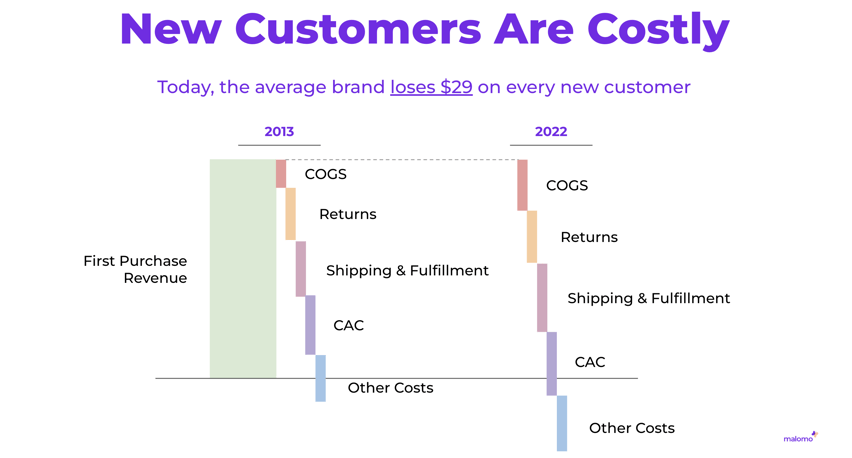
There are many factors leading to this significant increase in the cost to acquire customers. Some of them are iOS privacy changes, inflation, increased competition, supply chain disruption, the return of in-person shopping, and more.
If you're left wondering, "where's the profit?" - that's a fair question. And an even more important question might be, how can modern brands survive this loss?
The answer to both of these very valid questions is: repeat customers. Profits from repeat customers are healthy and growing. In fact, profitability from your loyal customers has grown 35% over the same time period.
The message is simple: There is no sense in acquiring new customers if you don't have a plan to keep them coming back.
The first step of that plan is to reduce customer churn. One of the biggest churn risks in the customer lifecycle is while they are waiting for their package to arrive. In fact, 84% of customers won't return to a brand after just one bad shipping experience. And unfortunately, bad shipping experiences are still happening at an inexcusable rate.
For most consumers, the order tracking experience goes something like this:
- You start by browsing a new store which is usually a super engaging, branded, and fully immersive experience.
- Once you buy, the experience completely flips. You’re sent a very transactional, stale email telling you your order has shipped, and this is typically the last communication you receive from the brand about your delivery.
- Then, when you click to track your package, you’re taken to a carrier tracking page that is often times confusing and difficult to understand.
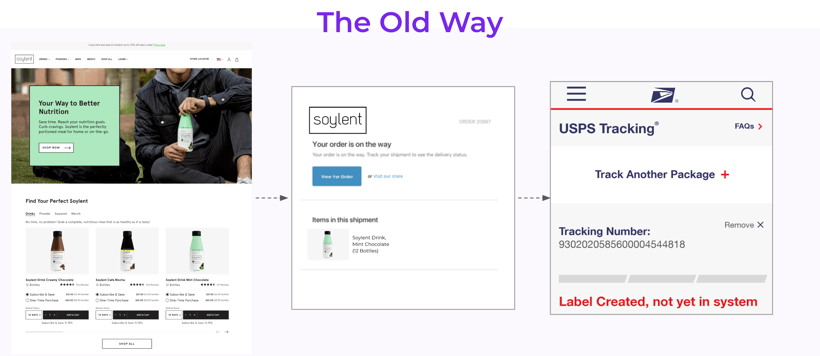
When you see the experience laid out like this, it feels very jarring and disjointed, right? It’s almost like the brand is giving you the impression that once we’ve gotten your money, we don’t care much if at all about the experience you have after that.
What's interesting though, is one of the most viewed pages for ecommerce brands today is the order tracking page. In fact, on average, customers check the tracking of their order 4.6 times. That's why on average, 15% of site traffic is going to an order tracking page. And yet, most brands still use standard, out-of-the-box tracking pages.
But brands that are focused on retention (as you are, since you're reading this today), are following the below journey instead.
-
They start by turning off generic Shopify post-purchase emails and move those over to their ESP, where they have full control over branding and content.
-
They also have more control over the notifications that are sent, giving them the ability to proactively communicate updates with their customers.
-
Then instead of sending customers to a UPS page, brands send them to a tracking page on their own site that gives them real-time status updates in human-friendly messaging, alongside estimated delivery dates.
-
And both their emails and their tracking pages become marketing assets that brands use to drive buyers back to purchase, provide useful interactive content, and educate them on their products or brand.
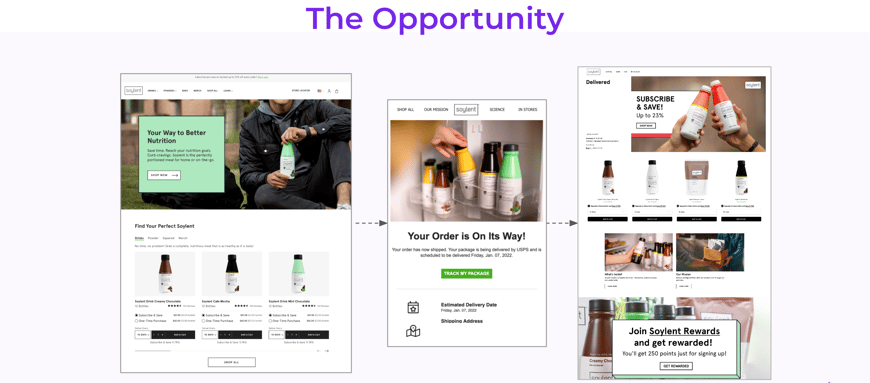
Not only does the above strategy allow for a better experience if everything goes to plan, it also allows brands to proactively update customers if anything goes wrong along the way.
Customers expect delays in today’s logistics climate. What they don’t appreciate is not being made aware when things go awry. So, the ability to proactively notify customers in such circumstances can significantly reduce customer churn.
Now that you've learned how to reduce churn with better shipment tracking, let's look at how you can increase repeat purchase rate.
First, simply bringing customers who click to track their package back to your site is a win in and of itself. However, that also gives you an opportunity to surprise and delight your customers.
One common and effective use case is to segment your subscribers and non-subscribers. Because as we mentioned before, we know that the number one thing we can do to keep customers coming back is get them in the subscription program.
So, for non-subscribed customers, why not use this opportunity while they are super excited about your brand to drive subscription sign-ups?
The below example shows how a Malomo customer, Soylent, has done exactly that.
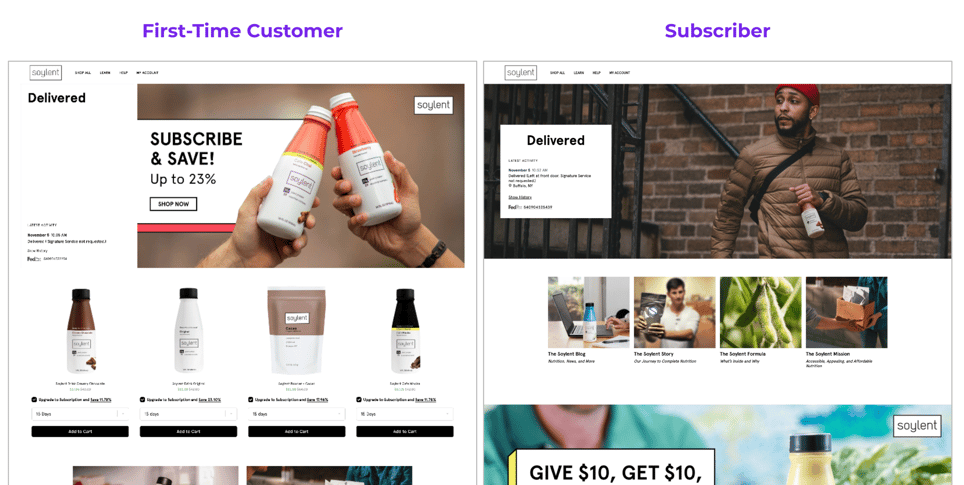
On top of that, for non-subscribers, they are using Rebuy to surface product recommendations, which is another great tactic on the tracking page. Across the board, Malomo customers see a 3% repeat purchase rate simply by suggesting products in the order tracking experience.
Another great way to make the most of your order tracking page is to drive reward program sign-ups. And if a customer is already in the subscription and rewards program - that means you have a loyal fan. And with that in mind, why not promote your referral program to your must loyal customers?
This easy use case turns your retention tactics into a lower-cost acquisition channel. Remember, this is a time in the customer journey when they are super excited. So, brands who are not capitalizing on the post-purchase journey are missing out on massive results.
For example, Soylent saw a 54x ROI on their order tracking program, with the help of their agency partner Electriq Marketing.
Another example comes from ILIA Beauty. They saw similar results when adding their referral program front and centre on their order tracking page. By promoting their Friendbuy referral program on their order tracking page, they are creating a retention-to-acquisition flywheel.
Summary
There truly is no point in acquiring new customers if you don't have a plan to keep them. That plan can be incorporated throughout your customer touch points, including your referral and loyalty program, your customer communications, your onsite experiences, and your order tracking program.
FAQs
Still got questions about repeat customers? We've got answers. We cater to businesses that are already well established, so sometimes we breeze over some terms and concepts that could use a little bit more explanation if you're new around here.
Q: What is a repeat customer?
A: They are customers who have made at least two purchases from your website.
Q: Who is likely to become a repeat customer?
A: Satisfied customers who have a positive customer experience with a brand are more likely to become repeat customers. These existing customers are happy with the product or service they received and will return for future purchases.
Loyal customers who have a strong emotional connection to a brand or business are more likely to become repeat customers. They may be more forgiving of any issues that arise and are more likely to stay with the brand even if a competitor offers a similar product or service.
Returning customers who perceive that they are getting a good value for their money are more likely to become repeat customers. They may be willing to pay a premium for a quality product or service and are more likely to return if they feel they received good value for their purchase.
And, lastly, returning customers who find it convenient to purchase from a business are more likely to become repeat customers. This could include things like a user-friendly website, an easy checkout process, or a location that is convenient for them to visit.
Q: What is an example of a repeat customer?
A: An example could be a person who regularly buys running shoes from a particular sporting goods website. They may have found that the website offers a wide selection of high-quality running shoes and provides exceptional customer service. As a result, they continue to return to the store every time they need a new pair of shoes, and they may even recommend the store to their friends and family.
Other examples are people with subscription products and services where the repeat customer spends monthly for snacks, video streaming, or beauty products.
Q: Is a repeat customer better than a new customer?
A: A high repeat customer rate (RCR) is generally seen as a positive indicator of a business's success. It shows that customers are satisfied with their experience and are willing to continue doing business with the brand. It also helps to reduce the costs of acquiring customers and increase profitability, as it is easier to sell to them and typically less expensive to retain existing customers than it is to acquire new ones.
Q: What is the difference between a repeat customer and a loyal customer?
A: Sometimes, the terms "repeat customer" and "loyal customer" are used interchangeably. They actually have different meanings! Technically, a repeat customer is someone who makes multiple purchases but may not be emotionally connected to the brand or business.
People who are considered loyal customers have a strong emotional connection to a brand or business. They not only make repeat purchases but also actively advocate for the brand and are less likely to switch to a competitor. Loyal customers often feel a sense of trust, respect, and affinity for the brand and will likely join customer loyalty programs.
In other words, all loyal customers are repeat customers, but not all repeat customers are loyal customers. Repeat customers may simply be satisfied with the product or service and find it convenient to continue purchasing, whereas more loyal customers have a deeper relationship with the brand that goes beyond just satisfaction or convenience.
Q: What are the benefits of repeat customers?
A: Repeat customers spend more money than new consumers. By focusing on gaining more repeat customers, businesses can increase the customer lifetime value, which is the total amount of money a customer is expected to spend over their lifetime with the business. Businesses that focus on them can experience increased revenue and higher profit over time.
Attracting new consumers can be expensive. Repeat business costs are much lower since it is more about getting current customers who already know your brand to make another purchase. Plus, loyal and repeat customers promote the brands they love to their friends and family, which can help attract new consumers and increase revenue. Businesses that focus on acquiring more repeat customers can reduce their marketing efforts and allocate resources more efficiently.
They are more likely to be satisfied with a business's products or services, which can help build a positive brand reputation and create a competitive advantage. Building strong customer relationships with them can lead to repeat sales, increased loyalty, trust, and retention, which helps businesses thrive in the long run.
Q: Why should you focus on repeat customers?
A: Attracting new customers can be expensive and time-consuming, whereas retaining existing customers costs less. Repeat customers have already had a positive experience with the business, so they require less marketing and sales effort to convert.
Repeat customers buy higher-priced products or services, refer others to the business, and repeat customers resulting in a lower cost of acquisition compared to new customers. Looking at customer data and focusing on repeat customers results in a deeper understanding of good customer service and knowing a customer's needs and preferences, leading to improved customer satisfaction and repeat sales. By nurturing the customer relationship and providing good customer service, businesses can create a positive brand image and reputation that further strengthens customer loyalty.
Repeat customers are more likely to make repeat sales and spend more money, which can drive up revenue and a company's profitability. Additionally, customers may be willing to pay a premium price for products and services, further increasing profitable relationships.
Building a base of repeat customers results in businesses with a competitive advantage over other companies in the same industry. Customers are less likely to switch to a competitor, making it easier for the business to encourage repeat sales, maintain market share, grow its customer base, and boost revenue.
Q: How do you focus on repeat customers?
A: The first thing to do is to provide excellent customer service. This creates a positive experience for customers, increasing customer retention, increased loyalty, and repeat sales.
Personalize the customer experience by understanding your customer's preferences and needs. Businesses can personalize the customer experience to create a deeper connection with the customer and increase the likelihood of customers making repeat purchases.
Offering a loyalty program rewards customers with discounts, rewards, a positive referral, or other incentives for repeat sales can motivate customers to return to the same brand and make repeat sales.
After a customer makes a purchase, sending them personalized communications such as personalized emails, messages, or other forms of communication can help businesses stay top-of-mind with customers. This can help convert one time buyers into repeat customers and help create a sense of connection and loyalty.
By actively listening to customer feedback and addressing the concerns or issues of current customers. Customer feedback shows that businesses can improve the customer experience, encourage repeat customers, and build trust and loyalty.
Consistently delivering high-quality products or services can create a sense of trust and reliability, encouraging repeat sales.
Social media is also the digitally-savvy way to tap potential customers. It also reminds previous customers of the brand, keeps returning customers engaged, and provides a way to stay connected with returning customers. You can also you newsletters or other forms of communication to help your business maintain a relationship with more customers, bring more value to the customer experience, and stay top-of-mind.
Learn more about retention marketing.
Q: What is a good repeat customer rate (RCR)?
A: RCR is a metric used to measure the percentage of customers who make more than one purchase from a business or brand over a given period of time. It is a key performance indicator (KPI) based on customer data that is used to assess the loyalty of customers to a business, and it is often used to evaluate the effectiveness of customer retention strategies.
Q: How to calculate the repeat customer rate (RCR)?
A: To calculate the RCR, you would divide the number of customers who have made multiple purchases by the total number of unique customers during a specific time period, usually a month, quarter, or year. For example, if a business had 1,000 unique customers in a month and 200 of them made a second purchase in that same month, then the RCR would be 20% (200/1,000).
Q: What is the customer retention rate (CRR)?
A: The CRR is a metric used by many businesses to measure the percentage of customers who made previous purchases and continue to do business with the company over a certain period of time. It is typically calculated by taking the number of customers at the end of a period and dividing it by the number of customers at the beginning of that same period, then multiplying by 100 to get a percentage.
For example, if a company has 1,000 customers at the beginning of a year and 800 of those customers continue to do business with the company at the end of the year, the CRR would be 80%.
A high CRR is generally considered to be a good indicator of customer satisfaction and loyalty, which can lead to increased revenue and profitability for the business.

